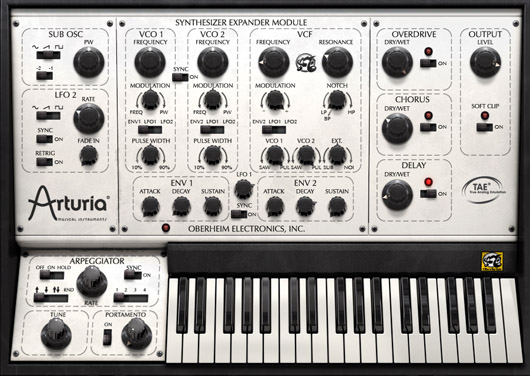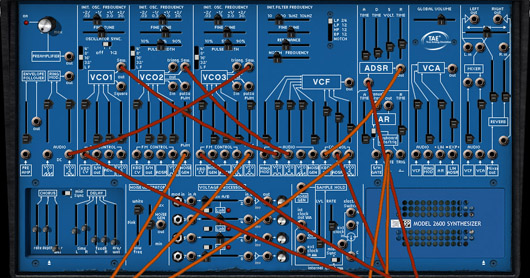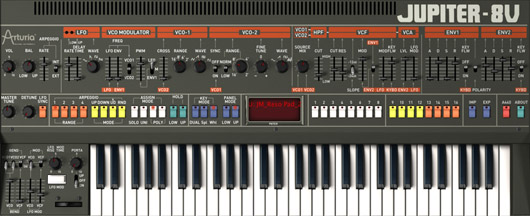Review: Arturia Next Generation Virtual Instruments
The French soft-synth maker Arturia recently repackaged 10 of its most popular analog-modelling virtual instruments […]

The French soft-synth maker Arturia recently repackaged 10 of its most popular analog-modelling virtual instruments into what it’s calling Next Generation versions—featuring new packaging, 64-bit compatibility, improvements in MIDI assigment capabilities, and overall enhanced performance. Here, we take a look at three of the instruments to see how these new editions hold up.
ARP 2600 V
Modelled after the legendary mini-modular ARP 2600 synthesizer, the ARP 2600 V can be a handful to approach if you have no experience with modular synthesis. Fortunately, this soft-synth comes with a plethora of decent presets that will get you started making noise instantly and, after a while, serve as a sort of tutorial to help figure out how best to piece the synth together using the virtual patch cables that connect all the different components. Aside from the three oscillators, the 2600 V comes with all the same parameters as the original ARP, which includes just about everything one would expect to find on such an in-depth synth: full filter section, complete envelope control, ring mod, noise generator, reverb, and much, much more. Also included is a soft version of ARP’s 1601 Sequencer, which allows the user to further control their sounds with 16 completely MIDI-synced steps. Again, there are plenty of presets which utilize this aspect of the 2600 V, so you can get started with it quickly and then tweak to your liking later on. The range of sounds possible on the 2600 V is perhaps its most alluring quality. From rich and full pads to cascading arpeggios, bell-like melodies, and otherworldly bleeps and bloops, the only limit to the sonic possibilities are the user’s patience and understanding of the synth itself.

Jupiter-8 V
The original Jupiter-8 is known for its full low end and trademark buzz, and the Jupiter-8 V delivers an amazingly comparable sound. Where a lot of soft-synths falter is in the higher end of the frequency spectrum, usually sounding flat or even harsh and causing producers to roll off the high frequencies while sacrificing a bit of brightness, but this synth is remarkably clear and present in that range. The filter section here is impressively responsive, the resonance is sharp and can even get a bit out of control (just like a real analog filter). There are quite a lot of options to tweak the sounds on the Jupiter-8 V—LFO, modulation, envelope controls, arpeggiator, detune, portamento, etc.—but it is nowhere near as complicated as the 2600 V, and if you turn enough knobs, you’ll usually end up with an interesting sound. There are also extra effects such as delay, reverb, chorus, and distortion which can be utilized via an extra panel found above the synth. But for the most part, you’re probably better off using whatever plug-ins you already have instead, or better yet, just staying out of the way of the rich tones one can easily conjure up from this virtual synth.

Oberheim SEM V (pictured at top)
The Oberheim SEM V is one of the more recent additions to Arturia’s line of analog emulators. It’s a rather simple polyphonic synth with two main oscillators, a standard filter section, sub-oscillator, two LFOs, overdrive, chorus, and delay. The sound is somewhat comparable to a Moog in that the tones can be biting or, when dipped by the filter, rounded off and smooth. The large buttons and relatively simple design make this one easily tweakable and perhaps the most fun of the three presented here. The included arpeggiator is ridiculously basic but unbelievably entertaining once you get it rolling. The soft-synth also features extended access to certain parameters which are controlled by a panel above the main synth. Here, the sounds can be customized much further utilizing more detailed controls based on the section of the keyboard being played or which of the eight voices is being used at the time. This section allows for simpler patches to become much more complex if the user wishes, adding another layer of customization for the ambitious—or restless—synth nerd.
With these three particular virtual instruments as our indicators, it seems likely that the rest of Arturia’s Next Generation line is of an equally impressive quality. Of course, like all soft-synths, there are inherent limitations to these instruments: Obviously, there is no physical surface (although with most DAWs, assigning the various parameters to a MIDI controller is considerably easy to do) and the field of vision is limited to the size of your screen. Also, to say that these synths are indistinguishable sonic copies of the equipment they represent may be a bit of a stretch, but that does not necessarily take away from the fact that each of these three soft-synths are of an exceptional sound quality. Considering how expensive and rare (especially in working condition) the real pieces of gear are, Arturia has made access to these sought-after sounds more affordable and reasonable than ever before, furthermore utilizing all the flexibility of MIDI and modern DAWs as well. Truthfully, it’s hard to think of any synths on the market today—software or hardware—for under $100 that allow for as much customization or that feature as rewarding sonic capabilities as Arturia’s Next Generation virtual instruments.
MSRP: $99

